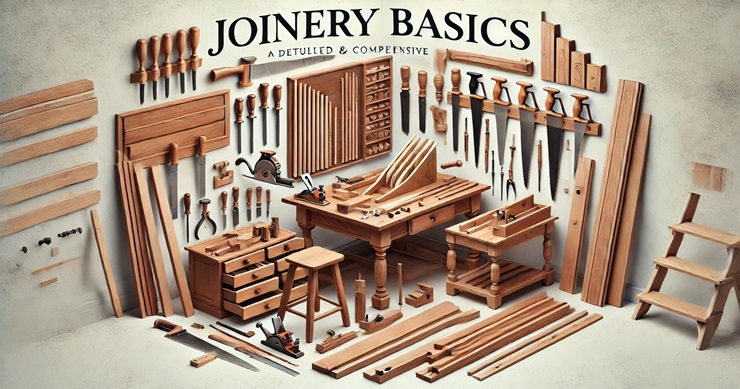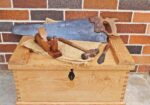A Comprehensive Guide to Essential Woodworking Techniques
Introduction:
Woodworking is a timeless craft that combines precision, creativity, and skill. For enthusiasts aiming to undertake high-end projects such as constructing timber-frame homes, assembling trestle tables, or crafting step stools, mastering joinery is crucial. This guide will delve into the essential joinery techniques, focusing on the edge joint and the mortise and tenon joint, to help you create beautiful and durable pieces without relying on nails and screws.
History and Background:
Joinery, the technique of connecting pieces of wood, has been a cornerstone of woodworking for centuries. From the dovetail joints found in ancient Egyptian furniture to the mortise and tenon joints used in medieval timber-frame buildings, the evolution of joinery techniques reflects the ingenuity and craftsmanship of past generations. Understanding these traditional methods provides a solid foundation for modern woodworking projects.
Core Concepts/Principles:
At its core, joinery involves creating strong, precise connections between pieces of wood. Two of the most fundamental joints are the edge joint and the mortise and tenon joint.
- Edge Joints:
- Definition: An edge joint connects the edges of two boards.
- Importance: Essential for creating larger surfaces from smaller pieces of wood.
- Process: Achieving a good edge joint requires ensuring that the two surfaces fit together perfectly without any gaps. The surfaces must be on the edge of the board, not the end grain, as the open cellular structure of end grain absorbs glue too deeply, preventing a strong bond.
- Mortise and Tenon Joints:
- Definition: A traditional joint where a tenon (a projecting piece) fits into a mortise (a corresponding slot).
- Importance: Known for its strength and versatility, this joint is crucial for connecting end grain to long grain.
Current Trends and Developments:
In contemporary woodworking, traditional joinery techniques remain highly valued, but they are often enhanced by modern tools and technologies. Advances in woodworking machinery, such as precision saws, drills, and jigs, have made it easier to achieve perfect fits and strong joints. Additionally, the rise of computer-aided design (CAD) software allows woodworkers to plan and execute intricate joinery with unprecedented accuracy.
Applications and Implications:
Joinery techniques are not just for traditional furniture making; they have broad applications across various woodworking projects. From cabinetry and framing to decorative woodworking and restoration projects, understanding and applying joinery techniques can significantly enhance the quality and durability of your work. Furthermore, the aesthetic appeal of hand-cut joints can elevate the craftsmanship of any piece, making it a treasured heirloom.
Challenges and Solutions:
Woodworking, especially joinery, presents several challenges, such as achieving precise cuts and ensuring strong bonds. Common issues include:
- Misalignment: Prevent this by regularly checking your progress against reference lines and using appropriate clamping techniques.
- Weak Joints: Ensure that all surfaces are properly prepared and that the right amount of glue is used.
- Material Movement: Account for wood expansion and contraction by leaving small gaps where necessary and choosing the right type of wood for your project.
Future Prospects:
The future of joinery looks promising, with innovations in tools and materials continually emerging. The integration of sustainable practices and materials is becoming more prevalent, encouraging woodworkers to use eco-friendly products. Additionally, advancements in digital fabrication and CNC technology are opening new possibilities for complex joinery designs and large-scale projects.
Case Studies/Examples:
Case Study 1: Traditional Timber-Frame Home Construction
- Project Overview: Building a timber-frame home using mortise and tenon joints.
- Challenges: Ensuring structural integrity and aesthetic appeal.
- Solutions: Utilizing precise measurements, high-quality materials, and traditional techniques.
- Outcome: A durable and beautiful home that stands the test of time.
Case Study 2: Crafting a Trestle Table
- Project Overview: Assembling a trestle table with edge joints and mortise and tenon joints.
- Challenges: Achieving smooth, gap-free joints and maintaining stability.
- Solutions: Using dowels for additional support and ensuring all cuts are accurate.
- Outcome: A sturdy and elegant table perfect for any dining room.
Conclusion:
Mastering joinery is a vital skill for any woodworker, providing the foundation for creating strong, durable, and beautiful pieces. By understanding and applying the principles of edge joints and mortise and tenon joints, you can elevate your woodworking projects and achieve professional-level results. Embrace the timeless art of joinery, and you’ll find endless opportunities for creativity and craftsmanship in your woodworking journey.
Detailed Guide to 15 Steps of Joinery
- Edge Joints
- Step 1: Preparation: Ensure the edges to be joined are smooth and square to both faces of the board.
- Step 2: Marking: Use a long straightedge to mark a reference line on one of the surfaces.
- Step 3: Planing: Attach the board to your worktable and use a bench plane to level the edge, checking for squareness regularly.
- Step 4: Fitting: Place the boards together and adjust until you achieve a flawless joint.
- Step 5: Gluing and Clamping: Apply glue to both edges, secure with clamps, and allow to dry.
- Doweling
- Step 1: Marking Locations: Mark dowel locations every 6-8 inches along the joint.
- Step 2: Drilling: Use a doweling jig to drill holes at the marked locations, ensuring proper depth.
- Step 3: Preparing Dowels: Bevel the ends and create a narrow groove along each dowel.
- Step 4: Gluing: Apply glue to the dowels and holes, then insert the dowels.
- Step 5: Clamping: Align the mating boards, secure with clamps, and allow the glue to set.
- Mortise and Tenon Joints
- Step 1: Marking the Tenon: Indicate the length and thickness of the tenon on the board.
- Step 2: Sawing the Tenon: Use a backsaw to cut along the marked lines, maintaining accuracy.
- Step 3: Chiseling: Trim the tenon to the guidelines using a chisel.
- Step 4: Marking the Mortise: Use a marking gauge to outline the mortise on the mating board.
- Step 5: Drilling the Mortise: Use a doweling jig to drill overlapping holes, then chisel to square the ends.
- Step 6: Fitting and Gluing: Test the fit, adjust if necessary, apply glue, and clamp the pieces together.
Types of Wood Joints:
- Butt Joint: Simple and quick, used for framing.
- Mitered Butt Joint: Angled for better aesthetics, though weaker.
- Half-Lap Joint: Stronger than butt joints, useful for flush connections.
- Tongue and Groove Joint: Durable with a large gluing surface, great for panels.
- Mortise and Tenon: Traditional and strong, used in furniture making.
- Biscuit Joint: Modern technique using beechwood wafers for secure edges.
- Pocket Joint: Precision joint for cabinetry, requires a jig.
- Dado Joint: Square-grooved slot, commonly used in cabinetry.
- Rabbet Joint: Edge dado, adds strength to cabinet backs.
- Dovetail Joint: Elegant and durable, ideal for visible joints.
Call to Action:
Join us in mastering the art of joinery! For more detailed guides, tutorials, and woodworking tips, visit our website and subscribe to our newsletter. Share your projects and experiences with us in the comments, and explore related content to take your woodworking skills to the next level.






